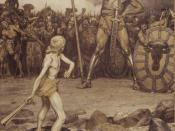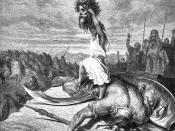The novel, The English Patient, by Michael Ondaajte constructs meaning through the use of tropes, images and symbolism, instead of merely portraying a linear set of events. There are many references within the text and tropes of covering, which serve to create and strengthen meaning. Bold imagery is also present, which erects another level of significance. Symbolism plays a vital role in the formation of meaning, with fire, religion, the English Patient's burned body and the desert being essential to the founding concepts of the novel. The self-awareness of the novel, as well as the multiple relaying of one event, also assist is the creation of meaning.
The biblical story of David and Goliath is also referred to frequently in the novel and is critical in assembling meaning. Goliath is a dominating, seemingly unconquerable character, while David is a mere boy with no apparent special qualities. Goliath represents the tyrannical arm of the British, while David is a metaphor for the revolt of the Indian people against the English.
According to the story, before Goliath's defeat by David the people lived in fear always waiting for a leader to free them. The mention of David in the novel can be seen as an allusion to Gandhi, the leader that freed the Indians from the English authority. This story foreshadows the break down of Imperialism and the consequent control gained by the Indian people in 1947. On a smaller level, the English Patient can be seen as Goliath and Kip as David. "When I see him at the end of my bed, I think that Kip is my David," this quote refers to both the story of David and Goliath and the painting by Carravaggio. In the painting, David holds the head of an old Goliath; youth always holds the...


